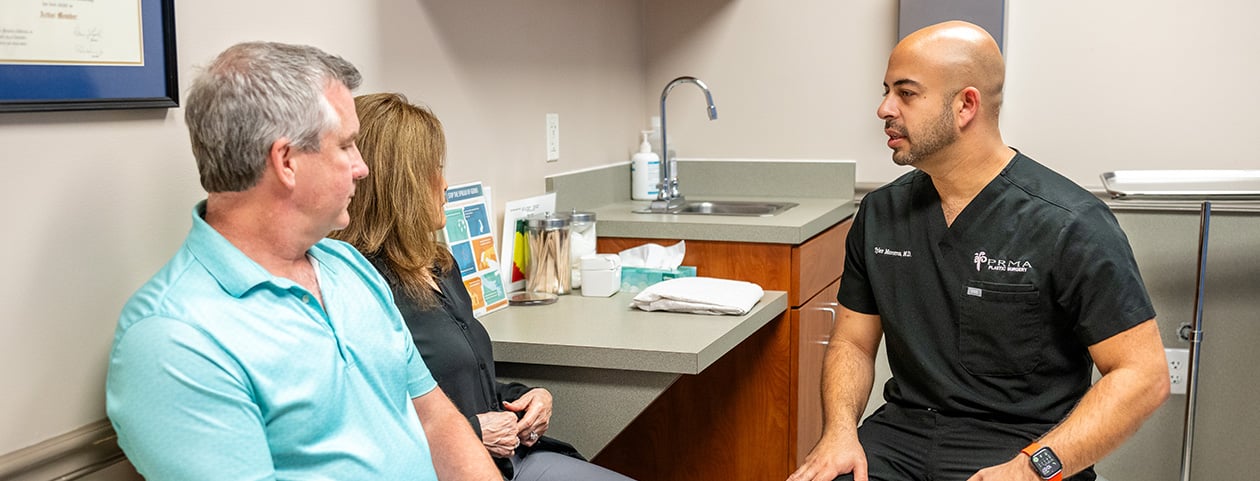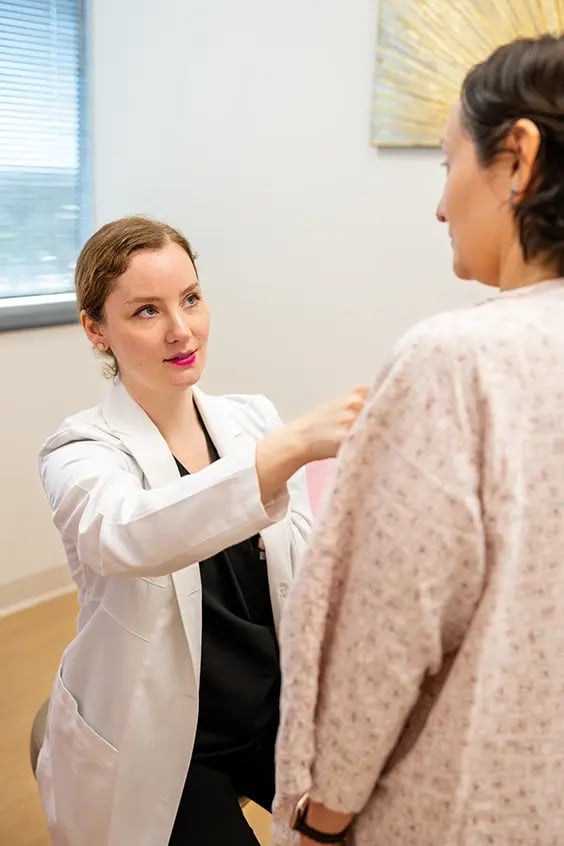
Post-Operative Care
What to Expect After Breast Reconstruction
Every recovery journey is unique, but one thing remains constant: our commitment to supporting you at every step. From your first hours in the hospital to the following weeks and months, PRMA provides detailed guidance, compassionate follow-up, and expert care to help you heal confidently. Whether you're managing drains, checking incision sites, or easing back into daily life, you are never doing it alone.
Surgical Drain Care
After breast reconstruction surgery, patients will have surgical drains placed to prevent blood and lymphatic fluid from building up under the skin, allowing for a quicker recovery.
The surgical drains look like small grenades (about the size of a fist) and have fluid measure markers around the outside. The drains are connected by a drainage tube that extends from an incision and is sutured into place so it doesn't accidentally slip out and leak.
When recovering from breast reconstruction, incision sites will be tender and sensitive. If the suture holding the drain in place is constantly tugged on, it could become quite painful. Safety pins can be used to secure the drains to your clothing to reduce the risk of tugging the drain. Simply stick the safety pin through the drain's tag or cap loop and attach the drain to your shirt or surgical bra. If pinning a drain to your clothing does not sound appealing, you may opt to attach it to a long, sturdy necklace. This is also an optimal choice while showering.
Before surgery, a PRMA nurse will provide a drainage log sheet. After surgery, it will be important to log the drain output at least twice daily. To accurately measure your drainage output, dispense the fluid into a measuring cup (provided by the nurse after surgery). This information will help monitor recovery. Before the drains can be removed, there must be less than 30cc of output a day for a 48-hour period.
To eliminate drain clogging, it is important to "strip" the drains a couple of times a day. Watch Nurse Amy demonstrate how to strip drains and measure drainage output properly.
.webp?width=645&height=968&name=PRMA%20-Surgical%20Drain%20Care%20-%20Post%20Op%20(2).webp)
After any surgery involving your abdominal area, such as DIEP flap breast reconstruction or fat grafting, you will need to wear an abdominal binder. The garment can look very overwhelming at first glance, but rest assured you can manage it!
The binder should be worn with the tag facing away from your body and the u-curve resting right above your buttocks. The wrap belts are coded with letters (A, B, C) to ensure proper match ups. The easiest way to remember where the wraps should be lined up and in which order they go is using the letters.
A = Abdomen (the middle wrap belt will go first, is marked with an “A,” and will lay over your mid-lower abdomen)
B = Below the abdomen (the wrap belt labeled with a “B” will follow and should connect just below your abdomen)
C = Chest (the last wrap belt to connect is marked with a “C” and will rest just below your chest)
For a more detailed demonstration of how to properly wear an abdominal binder after breast reconstruction surgery, check out this instructional video featuring PRMA nurse Denise and patient Terri.

What Does DIEP Flap Recovery Look Like?
-
Week 01
Patients stay 2-3 days in the hospital after surgery. Thanks to our ERAS protocol, patients feel well enough to be up walking the morning after surgery. Patients will also take a shower in the hospital. The rest of the first week is spent getting settled back home. Patients will slowly increase walking time and distance. A follow-up appointment in the office is scheduled for those traveling from out of state, which allows travel back home a week or so after surgery.
-
Week 02
A follow-up appointment is scheduled for local patients within two weeks after surgery. If drain output is low enough they are removed. During the second week, patients will begin easing into their post-operative range of motion arm exercises. By the end of the second week patients can switch from the surgical bra and abdominal binder to a wireless bra and panty girdle. (Be sure to get clearance from your doctor or nurse first.) Most patients also feel comfortable enough to drive. Driving is allowed as long as they are not taking narcotics.
-
Week 03During the third week after surgery, patients typically feel more like themselves. Most at-home medications can be resumed if they have not been restarted already. Please clear all medications with your physician first. Any remaining surgical drains are removed. Patients with low-impact/work-from-home jobs can return to work at this time if they desire.
-
Week 04During the fourth week, a follow-up appointment is scheduled with the surgeon. Planning stage 2 of the reconstruction (the revision stage) starts now. Patients should continue to increase cardio endurance as they feel able.
-
Week 05After the first month, many patients may experience new pains in the breast and abdomen as activity is increased. This is normal and will get better over time.
-
Week 06By week six, most patients will be released from all restrictions. Most patients are able to return to work as well. Remember, not everyone heals at the same rate. It is important to listen to your body as you resume all activities.
What You Need to Know About Prevena
Prevena is a special wound care dressing sometimes used to help prevent wound healing problems. Patients who are at higher risk for wound healing problems are those with BMIs greater than 30, a history of smoking, or diabetes. Sometimes, for very thin patients, Prevena is used to help with a tight incisional closure. The decision to use Prevena is usually determined during surgery based on the surgeon's expert judgment.
Help with your PREVENA Incision Management System is always a call away—800-275-4524.
Learn more about preventative wound care following breast reconstruction surgery here.
.jpg?width=1800&height=1200&name=PRMA2%200462%20(1).jpg)
